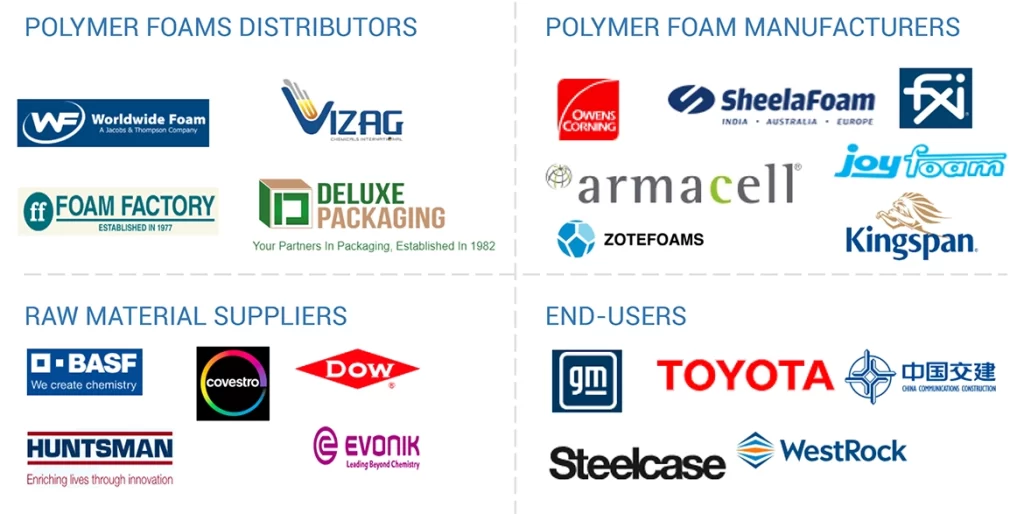The report “Polymer Foam Market by Resin Type (PU, PS, PO, Phenolic), Foam Type (Rigid, Flexible), End-Use Industry (Building & Construction, Packaging, Automotive, Furniture & Bedding, Footwear, Sports, & Recreational), and Region – Global Forecast to 2030″, is projected to grow from USD 102.61 billion in 2024 to USD 142.02 billion by 2030, at a CAGR of 5.6% during the forecast period. Recent advances in foam materials have produced lightweight, robust, high-performing foams with thermal insulation, soundproofing, and flame-retardant properties, making them widely used in the automotive, construction, and packaging industries. At the same time, the sustainable push has also resulted in the development of bio foams and recyclable foams driven by the need for environmentally friendly products owing to the local content policies that prohibit the use of certain materials. These developments, particularly the outlook for polymer foams that use less energy or polymers with less environmental impact, encourage expansion of the polymer foam market.
The building & construction segment is expected to account for the largest share of the polymer foam market by end-use industry during the forecast period in terms of value.
By end-use industry, the building & construction segment is estimated to have the largest market share by value. Due to the rising need for energy-efficient and environmentally friendly construction materials, the building and construction industry will continue dominating the polymer foams market. Various polymer foams including, but not limited to, polyurethane (PU) and polystyrene (PS), find applications in thermal and acoustical insulation as well as structural infill systems within walls, roofs, and flooring, thereby contributing to the building’s energy performance. In addition to these factors, concerns about green building practices and energy efficiency and associated government policies encouraging low-energy buildings have increased the use of polymer foams in the scope of both residential and commercial construction. Moreover, polymer foams have the advantage of being light in weight, hence less conducive to higher construction costs and enhancing the ability of the buildings to withstand better.
Download PDF Brochure: https://www.marketsandmarkets.com/pdfdownloadNew.asp?id=1011
By resin type, the polyurethane segment is expected to account for the largest market share in terms of value during the forecast period.
Based on resin type, the polyurethane segment is estimated to account for the largest share of the market during the forecast period. This unique market share can be attributed to polyurethane’s versatility and a vast range of applications in major sectors, including automotive, construction, packaging, and bedding and furniture sectors. Both rigid and flexible polyurethane foams are often chosen due to characteristics like durability and lightweight nature. Polyurethane is used for soundproofing, energy absorption, and thermal insulation applications in the building and construction industry. It is also found in the automotive sector and in sealing and cushioning functions. Thus, polyurethane’s ability to meet a wide range of functional requirements is one of the primary reasons for its dominance in the polymer foam market.
Asia Pacific is projected to register the largest market share during the forecast period.
Asia Pacific is estimated to lead the market during the forecast period. The Asia-Pacific region is expected to have the largest market share in the polymer foam market due to numerous factors. The rapid urbanization and industrialization of countries and areas in the Asia Pacific have led to a substantial increase in demand for polymer foams in construction industries, automotive, and packaging, especially in developing countries such as China, India, and Southeast Asian countries. The increasing construction activities in these regions utilize polymer foams in residential and commercial buildings for insulation, soundproofing, and structural uses. Also boosting the product demand is the region’s growing automotive manufacturing sector, which is on the rise due to lightweight materials, such as polyurethane and polystyrene foams, which help improve the efficiency of motor vehicles. Due to the expansion of the e-commerce and retail industries in the Asia Pacific region, there has also been an increasing requirement for polymer foams used in packaging. In addition, the growth of this market is facilitated by the presence of cheap raw materials and labor and the growing commitment towards investments in eco-friendly foam technologies.
Some of the leading players in this market include ARMACELL (Luxembourg), Sheela Foam Limited (India), Kingspan Insulation, LLC (Ireland), Owens Corning (US), and Zotefoams plc (UK).

